 Environmental activist, writer, wilderness traveler, Zen Buddhist student and teacher, Peter Matthiessen was born May 22, 1927 in New York City, New York. He was a CIA officer in his early 20s, one of the few acts of his life that he regretted. He co-founded The Paris Review, one of English language’s most important literary journals. His book Shadow Country won the National Book Award for fiction, and he won again in nonfiction for The Snow Leopard. He remains the only writer to have won in both categories.
Environmental activist, writer, wilderness traveler, Zen Buddhist student and teacher, Peter Matthiessen was born May 22, 1927 in New York City, New York. He was a CIA officer in his early 20s, one of the few acts of his life that he regretted. He co-founded The Paris Review, one of English language’s most important literary journals. His book Shadow Country won the National Book Award for fiction, and he won again in nonfiction for The Snow Leopard. He remains the only writer to have won in both categories.
A friend gave me The Snow Leopard when it first came out, and I’ve reread it over and over in the decades since then. Matthiessen movingly tells how, after his wife Deborah Love died of cancer, he accompanied the naturalist George Schaller in search of the elusive leopard on the Tibetan Plateau. The book is travelogue, natural world description, and a meditation on life and death.
In his honor I am reprinting a post I wrote after visiting a site with 10,000 Buddhas…. – Jadi

My sister Pam and her family lived in the New Territories. This part of China is on the mainland north of Hong Kong. While Hong Kong is the most densely and vertically populated city on the planet, the New Territories were still relatively quiet. The landscape consists of steep, lush jungle peaks that end in bays and inlets.


The region is growing, and changing fast. The bus from the apartment passes villages on hillsides or tucked into hamlets and harbors. Floating villages of traditional houseboats are minutes away. And then the high rises suddenly appear, row after row after row.

You head up through a bamboo forest where statues line both sides of the path to the monastery.
There are roughly 500 Arhan [1] statues in plastic, painted gold. Each one is unique.
Their expressions represent the experience of enlightenment. Other statues await once you reach the summit. I felt like I was in a tacky Buddhist Disneyland.

Then I got to the top and entered the main temple. Before the altar is a glass case; it contains Venerable Yuexi’s preserved body! His body (still perfectly intact) was exhumed eight months after his April 24, 1965 death. Yuexi was next embalmed with Chinese lacquer, his head and face covered in gold leaf. [2] The Diamond Indestructible Body of Yuexi’s robed corpse sits in the lotus position. I was oddly moved by his preserved body: with the sight, I had a glimpse of religious truth.
That feeling became surreal as we headed back to the bus stop.

We climbed down a different set of steps past my least favorite creatures: wild monkeys.
And from the meditative hillside of Ten Thousand Buddhas, we neared and then entered the shopping mall complex at Sha Tin.

As I say, the New Territories has both the traditional and the modern. They all line the same path.
NOTES: [1] To quote Wikipedia, “…in Theravada Buddhism, an Arhat is a “perfected person” who has attained nirvana. In other Buddhist traditions the term has also been used for people far advanced along the path of Enlightenment.” [2] Taking pictures inside the temple is not allowed.
In memory of Peter Matthiessen, 22 May 1927 – 5 April 2014
Photos and Text © 2015 Jadi Campbell. Previously published as Adventures in China’s New Territories 1: Ten Thousand Buddhas. Uwe’s photos of our earlier trips to Hong Kong and mainland China and his photography may be viewed at viewpics.de.
Click here for my author page to learn more about me and purchase my books.




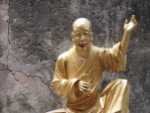





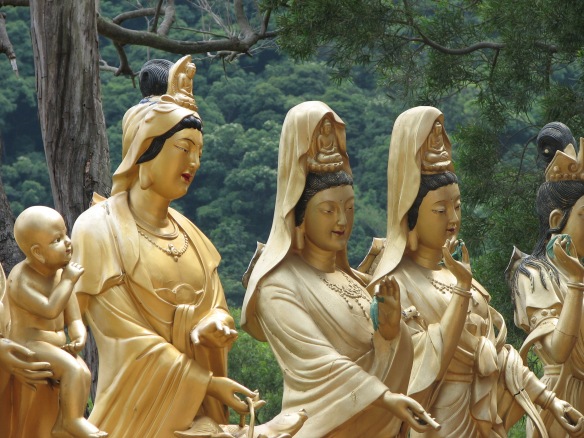


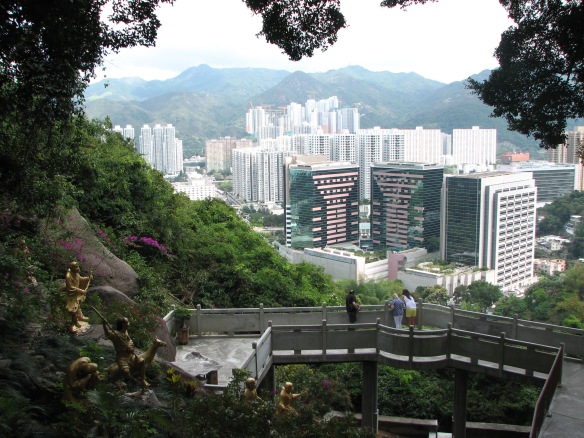

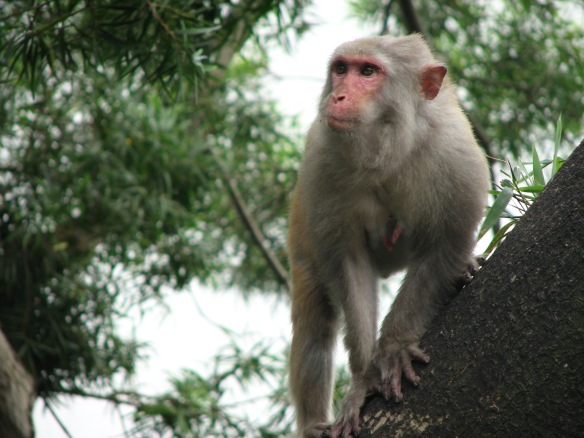













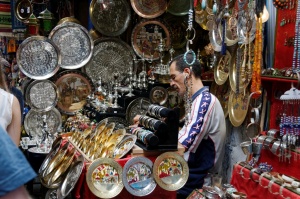

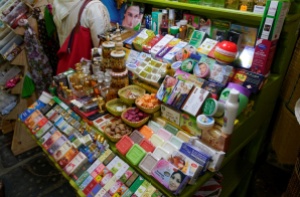


 Annie Edson Taylor was born on October 24, 1838 in Auburn, New York. On October 24, 1901, her 63rd birthday, she became the first person in history to go over Niagara Falls in a barrel and survive. Ms. Taylor hoped to secure her financial future with the stunt, but aside from some initial speaking engagements and a memoir she didn’t make much money. Her manager stole the barrel, and she had to use up her savings to hire private detectives to track him and the barrel down again. Annie died in Niagara County and her body is interred in the ‘Stunter’s Rest’ section of the Oakwood Cemetery in Niagara Falls on the New York side of the waters. In her honor I am reprinting a post I wrote after visiting the waterfalls of southern Laos. – Jadi
Annie Edson Taylor was born on October 24, 1838 in Auburn, New York. On October 24, 1901, her 63rd birthday, she became the first person in history to go over Niagara Falls in a barrel and survive. Ms. Taylor hoped to secure her financial future with the stunt, but aside from some initial speaking engagements and a memoir she didn’t make much money. Her manager stole the barrel, and she had to use up her savings to hire private detectives to track him and the barrel down again. Annie died in Niagara County and her body is interred in the ‘Stunter’s Rest’ section of the Oakwood Cemetery in Niagara Falls on the New York side of the waters. In her honor I am reprinting a post I wrote after visiting the waterfalls of southern Laos. – Jadi On our last trip to Laos we headed south to the quiet little city of Pakse in the Chapasak province. We wanted to see old ruins – and really spectacular waterfalls!
On our last trip to Laos we headed south to the quiet little city of Pakse in the Chapasak province. We wanted to see old ruins – and really spectacular waterfalls!



 When the French colonized Laos they came up with a bold (and ultimately quixotic) plan to build a railway through the region. They wanted to go around the waterfalls and create a faster, easier way to travel and ship goods either to the north, or to the southern Vietnam port of Saigon. The result is what a CNN article wryly refered to as “Laos’ first railway: 14 km of rust” [2].
When the French colonized Laos they came up with a bold (and ultimately quixotic) plan to build a railway through the region. They wanted to go around the waterfalls and create a faster, easier way to travel and ship goods either to the north, or to the southern Vietnam port of Saigon. The result is what a CNN article wryly refered to as “Laos’ first railway: 14 km of rust” [2]. But oh, those waterfalls on the Bolaven Plateau: we hiked in to as many as our young guide was willing to take us to. And we didn’t even need a barrel.
But oh, those waterfalls on the Bolaven Plateau: we hiked in to as many as our young guide was willing to take us to. And we didn’t even need a barrel.

























 We heard it before we saw it. Drums, lots of drums…
We heard it before we saw it. Drums, lots of drums…

 What tickles me most about the walls is that once you’re on them, you could be on a wide boulevard anywhere in the world. Except that this is China, and this isn’t a boulevard…. It’s a wide street located on top of Xi’an’s city walls. Travel doesn’t get any better than this.
What tickles me most about the walls is that once you’re on them, you could be on a wide boulevard anywhere in the world. Except that this is China, and this isn’t a boulevard…. It’s a wide street located on top of Xi’an’s city walls. Travel doesn’t get any better than this.



 Locals still go fishing in what looked like awkward and probably highly dangerous but effective fashion.
Locals still go fishing in what looked like awkward and probably highly dangerous but effective fashion.

 The chance to get into areas that are still relatively untouched by mass tourism.
The chance to get into areas that are still relatively untouched by mass tourism.

 Plus you never know when you’ll sail into the middle of a local festival. We literally did just that as we headed down river from Pakse to reach 4,000 Islands. A long boat race was going on, and Uwe and I didn’t need to be asked twice if we wanted to stay for a while and watch.
Plus you never know when you’ll sail into the middle of a local festival. We literally did just that as we headed down river from Pakse to reach 4,000 Islands. A long boat race was going on, and Uwe and I didn’t need to be asked twice if we wanted to stay for a while and watch.



 We booked our trip with a gentle young guide and a variety of boats. The infrastructure is simple compared to Germany or Hong Kong, but with cell phones and patience it all went smoothly. When you’re in a place as lovely as Laos is, it’s all good.
We booked our trip with a gentle young guide and a variety of boats. The infrastructure is simple compared to Germany or Hong Kong, but with cell phones and patience it all went smoothly. When you’re in a place as lovely as Laos is, it’s all good.




 When the French colonized Laos they came up with a bold (and ultimately quixotic) plan to build a railway through the region. They wanted to go around the waterfalls and create a faster, easier way to travel and ship goods either to the north, or to the southern Vietnam port of Saigon. The result is what a CNN article wryly refered to as “Laos’ first railway: 14 km of rust” [2].
When the French colonized Laos they came up with a bold (and ultimately quixotic) plan to build a railway through the region. They wanted to go around the waterfalls and create a faster, easier way to travel and ship goods either to the north, or to the southern Vietnam port of Saigon. The result is what a CNN article wryly refered to as “Laos’ first railway: 14 km of rust” [2].